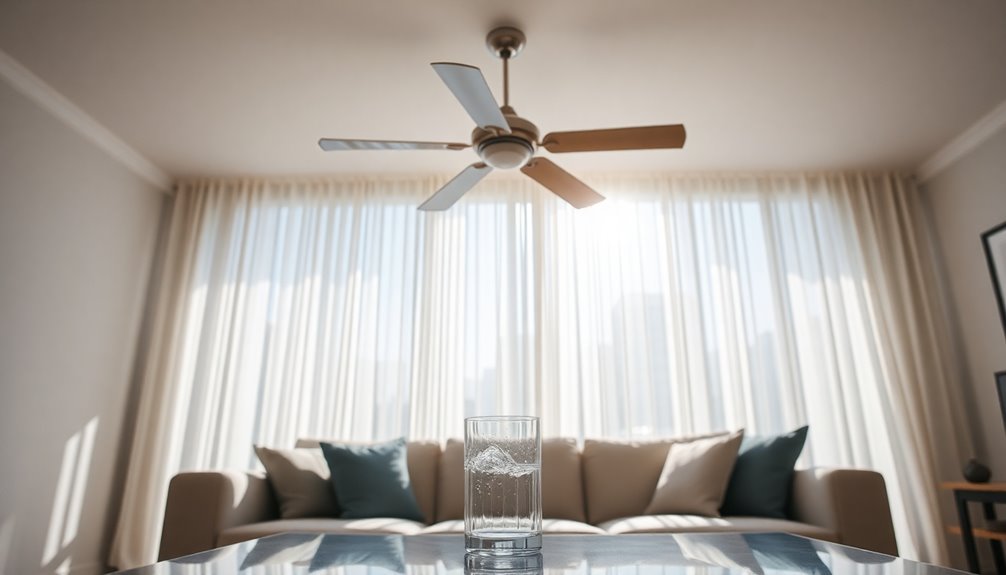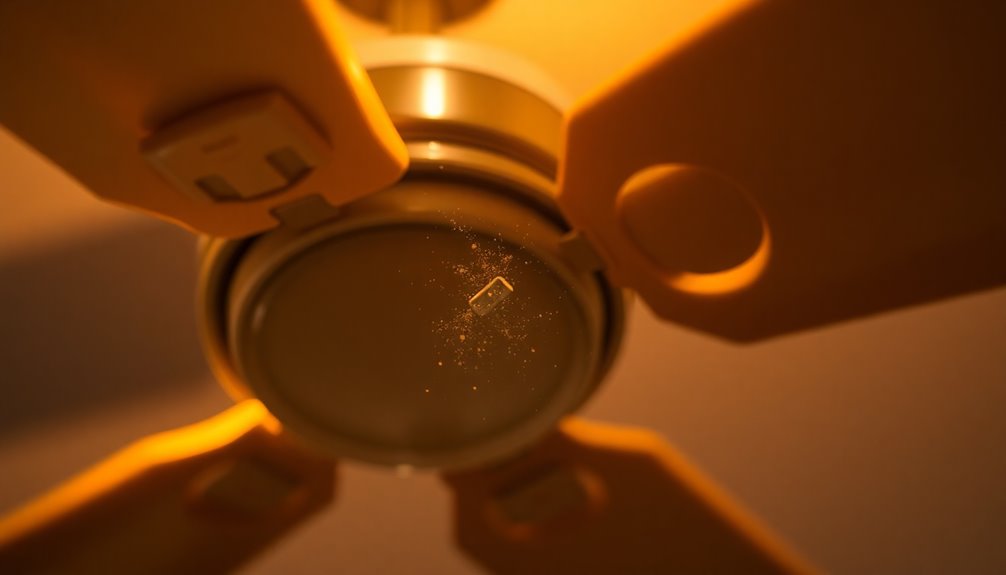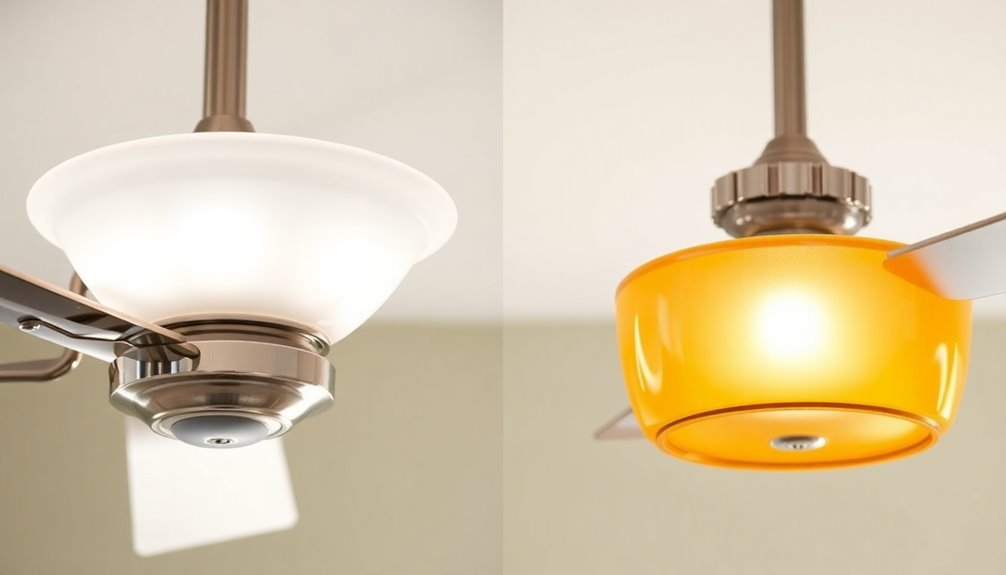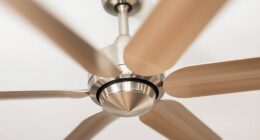Yes, ceiling fan direction really matters! When you set your fan to rotate counterclockwise in summer, it creates a cooling downdraft, enhancing the wind-chill effect. This allows you to raise your thermostat by up to 4 degrees and cut energy costs. In winter, switch it to clockwise to redistribute warm air efficiently and reduce heating bills by over 15%. Adjusting direction seasonally not only improves comfort but also leads to significant energy savings. Understanding these simple changes can make a big difference, and there's a lot more to explore about maximizing your fan's efficiency.
Key Takeaways
- Ceiling fan direction significantly impacts comfort and energy efficiency by enhancing the wind-chill effect in summer and redistributing warm air in winter.
- Counterclockwise rotation in summer allows thermostat settings to rise by up to 4 degrees, reducing air conditioning reliance and lowering energy bills.
- Clockwise rotation in winter can save 15% or more on heating costs by circulating warm air throughout the room.
- Seasonal direction adjustments are essential, as consistent fan direction can lead to discomfort and increased energy costs.
- Proper fan usage, including direction changes, can result in up to 30% savings on summer cooling costs and improved overall comfort.
Importance of Ceiling Fan Direction

The direction of your ceiling fan plays an essential role in maintaining comfort and efficiency in your home. By adjusting the ceiling fan direction, you can considerably enhance air circulation and boost energy efficiency.
In the summer, using counterclockwise rotation creates a rejuvenating breeze, maximizing the wind-chill effect that cools you down without lowering the thermostat. In winter, setting the fan to clockwise rotation redistributes warm air trapped near the ceiling, helping reduce heating costs by approximately 15% or more.
Proper fan direction not only optimizes your heating and cooling needs but also prevents stagnant air, ensuring even temperature distribution throughout your rooms. This is crucial for comfort in your home, as it keeps every corner feeling just right.
Seasonal changes in fan direction can lead to energy savings of up to 30%, making it clear how significant it's to pay attention to this detail. Remember, ceiling fans don't cool rooms; they cool you. Additionally, using ceiling fans in conjunction with a heat pump can further enhance overall energy efficiency and comfort in your living spaces.
Seasonal Direction Guidelines

To keep your home comfortable year-round, you need to adjust your ceiling fan's direction with the seasons.
In summer, set it to counterclockwise for a revitalizing breeze, while in winter, switch it to clockwise to help distribute warmth.
Making these simple changes can lead to significant energy savings and enhance your heating and cooling efficiency.
Summer Cooling Strategy
Summer brings the promise of warmth and relaxation, but it can also lead to sweltering indoor temperatures. To improve your comfort during the hotter months, your ceiling fan direction should be set to rotate counterclockwise. This summer cooling strategy creates a cooling downdraft that produces a wind-chill effect, making the air feel markedly cooler than the actual room temperature.
When the fan runs at high speed, you can increase your thermostat setting by up to 4 degrees without sacrificing comfort, resulting in energy savings of up to 30%. This efficient air distribution not only keeps you cool but also minimizes your reliance on air conditioning, helping to lower your energy bills. Additionally, it's crucial to ensure that your ceiling fan is well-maintained to prevent mechanical failure that could compromise its efficiency.
To verify your ceiling fan is set correctly for summer, stand directly beneath it and feel the airflow rushing down. If it's not, make the seasonal direction changes to achieve that invigorating breeze.
Winter Heating Optimization
As temperatures drop and winter settles in, adjusting your ceiling fan direction becomes just as important for comfort as it's in the summer.
To optimize heating, set your ceiling fan to rotate clockwise. This creates an updraft that redistributes warm air from the ceiling down into your living space, enhancing overall temperature circulation.
By running the fan at a low speed in this direction, you can save 15% or more on your heating bills while maintaining a comfortable environment.
Warm air naturally rises, but with the right ceiling fan direction, you can effectively circulate that warm air throughout the room. This prevents cold spots and reduces the workload on your heating system.
When the fan operates clockwise, you'll feel a gentle warm airflow moving downward—this indicates effective heat distribution.
How to Change Direction

Changing the direction of your ceiling fan is a straightforward process that can enhance comfort in your space. By adjusting the ceiling fan direction, you can improve air movement for both cooling and heating needs.
Here's how to change the direction safely:
- Turn Off the Fan: Always make certain the fan is off and has come to a complete stop for safety.
- Locate the Ceiling Fan Switch: For fans with pull chains, look for the reversing switch on the fan body. Toggle this switch to change the blade rotation direction.
- Use Remote Controls: If your fan has remote controls, check for a button designated for changing direction. Make sure the fan is off, then press the button.
- Smart Fan Adjustments: If you have a smart ceiling fan, use the mobile app or voice command to change the direction without manual intervention.
Always consult the manual for specific instructions, as methods to change the direction might vary by model.
Additionally, adjusting the fan direction can lead to increased energy savings as it helps maintain a comfortable temperature throughout the year.
Whether you want to turn clockwise for winter warmth or turn counterclockwise for summer cooling, these steps make certain effective fan operation.
Timing for Adjustments

When it comes to adjusting your ceiling fan direction, timing plays a crucial role in maximizing comfort and energy efficiency. A great time to change your fan's direction is during Daylight Savings Time adjustments.
As spring rolls in, set your fan to rotate counterclockwise for summer, creating a revitalizing breeze that enhances airflow. When winter arrives, switch it to clockwise to circulate warm air effectively.
Making these seasonal changes can greatly impact your energy efficiency, potentially saving you up to 30% on cooling costs in summer and around 15% on heating during winter.
Benefits of Proper Usage

Proper usage of ceiling fans offers substantial benefits that can enhance your home's comfort and energy efficiency. By adjusting the ceiling fan direction according to seasonal needs, you can create a comfortable living environment while maximizing energy savings.
Here are four key benefits of proper usage:
- Energy Savings: You can achieve energy savings of up to 30% by optimizing airflow with seasonal adjustments—counterclockwise in summer for cooling and clockwise in winter for redistributing warm air.
- Improved Heating Systems Efficiency: Running your fan at lower speeds during winter helps push warm air down, enhancing heating systems' efficiency and potentially reducing utility bills by 15% or more.
- Enhanced Air Circulation: Proper fan direction enhances air circulation, contributing to a more pleasant living environment year-round.
- Wind-Chill Effect: Fans create a wind-chill effect, allowing you to raise thermostat settings by 4 degrees in summer without sacrificing comfort, leading to additional energy savings.
Common Misconceptions

You might think ceiling fans cool your entire room just like air conditioning, but that's a common myth.
It's also easy to get confused about which direction your fan should spin throughout the year.
Plus, running fans in empty rooms won't help with cooling or heating, so let's clear up these misconceptions.
Fan Cooling Myths
Ceiling fans are often misunderstood, leading to several common myths about their functionality and effectiveness.
It's important to clear up these misconceptions so you can use your ceiling fans wisely.
- Fans Cool Like Air Conditioning: Unlike air conditioning, ceiling fans don't lower room temperatures. They create a cooling breeze that affects your comfort through the wind-chill effect.
- Running Fans in Empty Rooms: Many believe that leaving fans on cools empty rooms. In reality, they're ineffective without people present to feel the breeze.
- Consistent Fan Direction: It's a common myth that fans should always spin in one direction. You should switch to counterclockwise in summer for cooling and clockwise in winter for heat distribution.
- Higher Fan Speeds Are Always Better: Some think higher speeds mean better cooling, but lower speeds can be more effective in winter, circulating warm air without drafts.
Understanding these fan cooling myths can lead to better energy savings and more effective use of your ceiling fans, especially with proper seasonal direction changes.
Directional Effect Misunderstandings
Numerous misconceptions surround ceiling fan direction and its impact on comfort and energy efficiency. Many people think ceiling fans can actually lower room temperatures like air conditioning, but that's not true. They create a wind chill effect that cools you, not the air.
Another common misunderstanding is that fans should always spin in the same direction. To enhance comfort and energy efficiency, you should adjust your ceiling fan direction seasonally—counterclockwise in summer for cooling and clockwise in winter to circulate warm air.
Some folks believe running ceiling fans in unoccupied rooms contributes to cooling, but that's misleading. Fans only provide comfort when people are present since they don't cool the room itself.
Additionally, many underestimate how significant fan direction is for energy costs. Proper adjustments can save you up to 30% on cooling costs in summer and 15% or more during winter heating. Ignoring seasonal adjustments can lead to stagnant air, making you rely more on your heating or cooling systems, which negatively impacts both your comfort and energy consumption.
Year-Round Usage Confusion
When it comes to ceiling fans, confusion often arises about their year-round usage and effectiveness. Many homeowners fall prey to misconceptions that can hinder energy efficiency and comfort.
Here are some common misunderstandings regarding ceiling fan direction:
- Cooling vs. Temperature: Ceiling fans don't actually lower room temperatures; they create a cooling breeze that makes you feel cooler.
- Constant Direction: It's a misconception that fans should always rotate in one direction. During summer, set the fan counterclockwise for a cooling effect, and switch to clockwise in winter to redistribute warm air.
- Running in Empty Rooms: Running a ceiling fan in an unoccupied space doesn't effectively cool or heat the room. It simply wastes energy.
- Timing for Direction Change: You should change directions at the beginning of summer and winter seasons to optimize comfort and improve energy efficiency.
Understanding these points not only clears up confusion but also guarantees that you're using your ceiling fans effectively throughout the year.
Energy Efficiency Insights

Adjusting ceiling fan direction seasonally can greatly enhance your home's energy efficiency. By utilizing counterclockwise rotation in summer, you create a cooling breeze that boosts the wind-chill effect, allowing you to raise your thermostat by about 4 degrees without sacrificing comfort. Conversely, in winter, a clockwise rotation helps circulate warm air, enabling you to lower thermostat settings and potentially reduce utility bills by over 15%.
Here's a quick breakdown of the energy savings:
| Season | Ceiling Fan Direction | Benefits |
|---|---|---|
| Summer | Counterclockwise | Enhances cooling breeze; raises thermostat settings |
| Winter | Clockwise | Circulates warm air; lowers thermostat settings |
These seasonal adjustments optimize air circulation and considerably improve energy efficiency, potentially reducing heating and cooling costs by up to 30%. With a ceiling fan consuming much less energy than air conditioning units, it's a cost-effective solution for temperature control in your home. By making these small changes, you not only guarantee comfort but also contribute to better home energy management practices.
Frequently Asked Questions
Does Reversing a Ceiling Fan Really Work?
Yes, reversing a ceiling fan really works! When you switch the direction, you're creating an updraft in winter or a downdraft in summer.
This simple adjustment helps redistribute warm air or enhances cooling, making your space more comfortable. You can save on energy costs too—up to 15% in winter and keep your thermostat settings higher in summer without sacrificing comfort.
Just flip that switch or use your remote for maximum efficiency!
Which Way Should a Ceiling Fan Go to Cool a Room?
To cool a room effectively, you should set your ceiling fan to rotate counterclockwise. This creates a downdraft that enhances your comfort through the wind-chill effect.
When the fan runs in this direction, you can feel the cool air rushing down, allowing you to raise your thermostat by a few degrees without sacrificing comfort.
Don't forget to run the fan at a higher speed during summer for ideal airflow and cooling!
Why Does My Ceiling Fan Make My Room Hotter?
You might be wondering why your ceiling fan makes your room feel hotter, especially when you expect a cooling breeze.
It could be that the fan's set direction is causing warm air to circulate rather than creating a revitalizing wind-chill effect.
Additionally, if the fan's blades aren't angled correctly or if it's not the right size for your room, it mightn't be moving enough air to enhance your comfort, leaving you feeling warm.
What Happens if a Ceiling Fan Rotates in Opposite Direction?
If your ceiling fan rotates in the opposite direction, you might feel uncomfortable.
A clockwise rotation in summer pulls cool air up, making the room feel warmer instead of cooler. In winter, a counterclockwise rotation fails to circulate warm air effectively, leaving cold spots.
This incorrect direction can force your heating or cooling systems to work harder, leading to increased energy costs.
Adjusting the fan direction based on the season can enhance comfort and efficiency.
Conclusion
In the dance of air, you're the conductor, guiding the flow with a flick of the switch. When summer's heat swirls in, let your fan spin counterclockwise, creating a cool breeze that whispers relief. As winter's chill settles, reverse the tempo to clockwise, spreading warmth like a cozy blanket. Embrace these simple changes and watch your comfort and energy savings waltz together. So, tune into your ceiling fan's rhythm, and let your home sing in harmony year-round!









